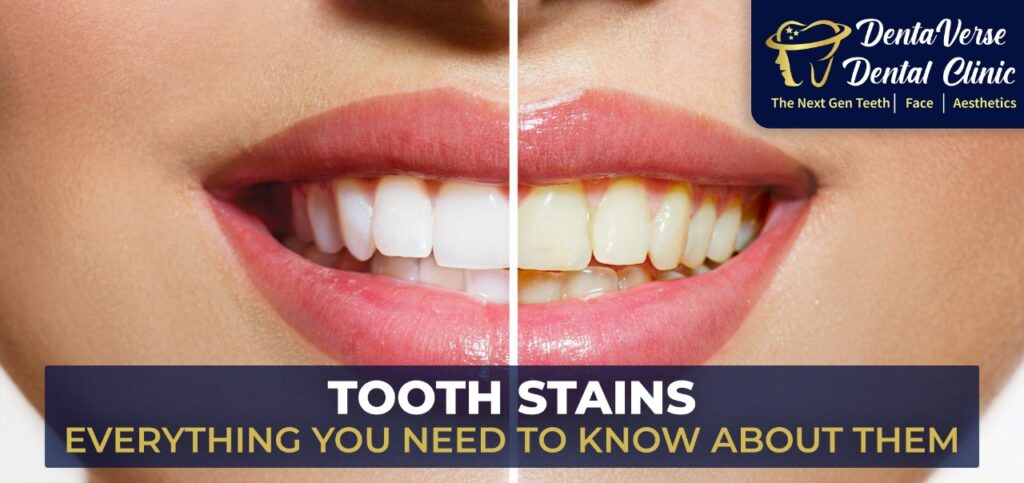
Teeth stains are a common dental problem that can affect anyone. There are numerous reasons why you can run across this issue. In addition to food and drink, a number of additional factors have a role in this issue. In addition to smoking, tooth damage, ageing, and prescription medicines, other causes might result in tooth discolouration.
Any of these stains present a challenge because they impair the aesthetics of your teeth. Some people have both types of stains on their teeth, which might show up on the tooth’s surface or deep within the tooth enamel. This page will cover every aspect of tooth discolouration, including its types, causes, and treatments.
CAUSES OF STAINS ON THE TEETH
Teeth stains can be caused by a variety of circumstances. Biological factors, such as the transparency of your tooth enamel and the ability of specific foods and beverages to stain your teeth, can also contribute to the causes we’ve already covered. Many factors can contribute to tooth discolouration, some of which you may have been able to prevent while others are beyond your control. This detailed list can help you determine the cause of tooth discolouration and, in many cases, can help you prevent further tooth decay.
- Diagonal Care
Poor dental hygiene, such as insufficient brushing or flossing, can cause teeth to become discoloured.
- A Disaster Illness
Any injury, sickness, or disease that prevents the creation of enamel, whether it happens in the womb or during tooth development, can cause discolouration in children’s teeth. Adult teeth may become discoloured as a result of trauma.
- Interventions In Medicine
Teeth can become stained by a variety of pharmaceuticals, such as antihistamines, chemotherapy, blood pressure meds, and some antipsychotics. Sometimes medical procedures themselves can cause teeth to become discoloured.
- Snakes & Beverages
Coffee, tea, dark drinks, red wine, and even some fruits and vegetables can discolour teeth.
- Tobacco
Both tobacco use while smoking and chewing have the potential to discolour teeth.
ARE THERE DIFFERENT KINDS OF TOOTH DISCOLORATION?
Teeth might become discoloured due to surface stains, actual changes in the structure of your teeth, or a combination of the two. Dental experts have identified three main categories of tooth discolouration:
- The Teeth Have Internal Staining
Intrinsic stains are those that penetrate underneath the surface of the tooth. It occurs when substances that cause stains seep through the enamel of the tooth and accumulate inside it. Fluoride intake that is too high has also been associated with neurotoxicity, especially in children. Although it is harder, it is still feasible to remove naturally discoloured teeth. To eliminate ingrained tooth discolouration, professional or at-home chemical teeth-whitening procedures like White strips may be required.
- Teeth-Staining on the External Side
Extrinsic tooth stains are stains that are visible on the tooth’s surface. It occurs when stains, such as coloured residue from food or drink, build up in the protein-based layer that protects tooth enamel. The main reasons for extrinsically discoloured teeth are smoking, drinking a lot of coffee and tea, drinking wine, and drinking cola drinks. This type of tooth discolouration can be removed successfully with regular dental cleanings and the use of whitening toothpaste.
- Age-Related Teeth Staining
Age-related tooth stains could be the result of both intrinsic and extrinsic tooth discolouration. Because dentin, the basic tissue of the tooth, ages naturally, teeth become darker as you get older. As a tooth ages, its protective enamel thins, exposing more dentin. Teeth yellow with age in the majority of people for these innate reasons for discolouration as well as extrinsic variables including the effects of particular foods, drinks, and smoking.
HOW CAN TEETH STAINS BE REMOVED?
- Updating Suitable Oral Hygiene
Your initial course of action should be to practice good dental hygiene if you have this cosmetic issue. Start by decreasing your intake of beverages that stain your teeth, such as soda, red wine, coffee, and tea. To avoid having the liquid directly contact your teeth, you can drink these beverages with a straw. All dentists share the belief that chewing and smoking tobacco are the main contributors to this aesthetic issue.
Reduce your sugar intake since it stops the growth of the bacteria Streptococcus mutants in your mouth. Issues like gingivitis and plaque are to fault. After drinking any beverage or sweets, be sure to brush your teeth as soon as you can.
- Professional Whitening
To speed up the whitening process, a dentist will apply professional whitening in-office utilizing specialized whitening tools and methods. To treat the region, your dentist will apply a hydrogen peroxide solution. For particular products, it could be required to accelerate the bleaching process with heat and specialized light. Other products that are solely available to professionals will have a higher whitener concentration, perhaps with desensitizer, and a specific tray of some kind for better whitener adhesion. The procedure is safe when carried out by a licensed dentist.
CONCLUSION
Everyone these days strives to have a radiant, healthy smile. Just be smart about it to keep your grin intact. Avoid using over-the-counter or DIY at-home whitening products without first consulting your dentist about the kinds of stains on your teeth. If you know how to safely whiten your teeth, you’ll be able to smile broadly for a very long time.




